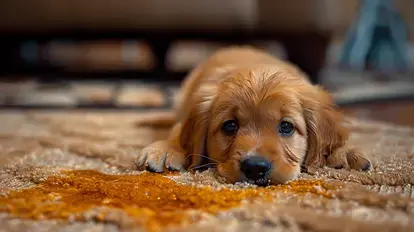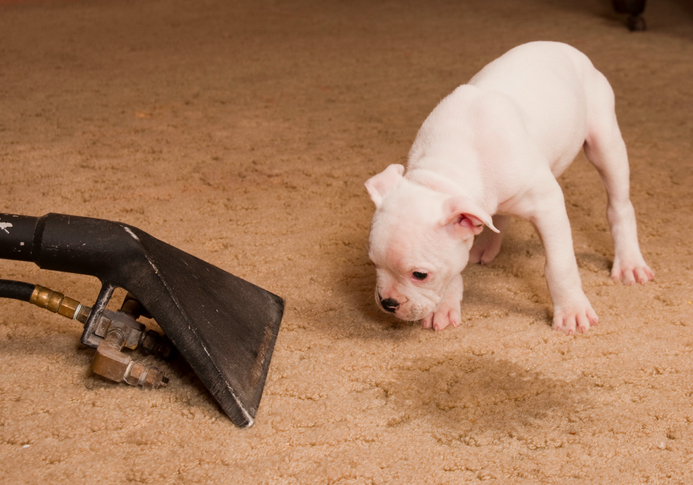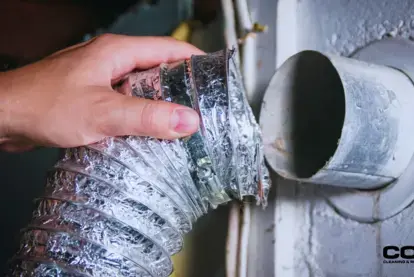
How to Remove Pet Odor from Carpet
Contact COIT for a professional cleaning!
Pets bring joy and companionship into our lives, but they can also leave behind challenging odors on our carpets. Addressing these accidents quickly is important to maintain a clean home environment.
This guide will provide you with the most effective methods to tackle pet stains and odors and keep your carpets looking fresh and clean.
Immediate Steps for New Stains
1. Blot the Area
When you discover a fresh pet stain, immediate action is essential.
Start by blotting the area to absorb as much moisture as possible. Place a thick layer of paper towels on the wet spot, followed by a layer of newspaper. Stand on this padding for about a minute to soak up the urine.
Repeat this process until the area is barely damp. This initial step helps prevent the urine from seeping deeper into the carpet fibers and padding.
2. Rinse and Blot
Once you have absorbed most of the moisture, rinse the area with cool water. Avoid using hot water or steam, as this can set the stain and make it more challenging to remove.
After rinsing, blot the area again with clean paper towels to remove excess water. This step helps dilute the urine and remove any remaining residue from the carpet fibers.
3. Apply Enzymatic Cleaner
To break down the odor-causing molecules, use a pet-safe enzymatic cleaner. These cleaners contain natural enzymes that digest organic materials, effectively eliminating both stains and odors.
Follow the product instructions carefully, ensuring you apply enough cleaner to penetrate the carpet fibers. Allow the enzymatic cleaner to sit for the recommended time, usually around 10-15 minutes before blotting it up with clean towels.
This step is crucial for thoroughly removing the urine and preventing your pet from returning to the same spot.

Dealing with Set-In Stains
1. Identify the Stains
Set-in stains can be more challenging to locate, especially if they have dried and become less visible. Use a black light to identify old urine stains. Under the black light, pet urine will appear as a dull yellow or greenish glow.
Once you locate the stains, lightly outline the areas with chalk to make them easier to target during cleaning.
2. Deep Clean
For deep-seated stains, renting a carpet cleaner or extractor from your local hardware store can be highly effective.
Use plain water with these machines, as chemicals can sometimes react with the urine and make the odor worse. Follow the machine’s instructions carefully, going over the stained areas multiple times to ensure thorough cleaning.
Avoid using steam cleaners, as the heat can set the stain and odor by bonding the proteins in the urine to the carpet fibers.
3. Neutralize Odors
After deep cleaning, apply a high-quality pet odor neutralizer. These products are available at pet supply stores and are designed to eliminate odor-causing bacteria.
Before using the neutralizer on the entire stained area, test it on a small, inconspicuous part of the carpet to ensure it won't cause discoloration or damage.
Follow the product instructions, applying the neutralizer generously to the cleaned area and allowing it to dry completely. This step ensures that any remaining odor is effectively neutralized.
Preventive Measures
1. Regular Grooming
Regular grooming can significantly reduce the amount of shedding and dander that your pets contribute to your carpets.
Brush your pets frequently to remove loose hair and dead skin cells. This practice helps minimize the accumulation of pet-related debris in your carpets, making it easier to maintain a clean and odor-free environment.
2. Use Washable Covers
Protect your carpets and furniture by using washable covers. These covers can be easily removed and cleaned, preventing pet hair, dirt, and odors from embedding into your carpet fibers.
Choose covers made of materials that are both durable and easy to wash, ensuring they provide effective protection without sacrificing comfort.
3. Train Your Pets
Training your pets to use designated bathroom areas is crucial in preventing future accidents. Positive reinforcement techniques, such as rewarding your pets with treats and praise when they eliminate in the appropriate place, can be highly effective.
Consistency is key—make sure all family members are on board with the training process to avoid confusing your pets.
Chemical Warnings
Avoid Ammonia and Vinegar
While ammonia and vinegar are commonly used in household cleaning, they should be avoided for pet stain removal. These substances can attract pets back to the cleaned area due to their strong scents, encouraging them to mark the spot again.
Instead, opt for pet-specific cleaning products that are designed to neutralize odors without attracting pets.
Health and Safety
When using cleaning agents, it’s essential to consider the health and safety of your pets. Large amounts of baking soda, for example, can be toxic to pets if ingested.
Keep your pets away from treated areas until the cleaning process is complete and the area is thoroughly dry. This precaution helps prevent accidental ingestion or exposure to potentially harmful substances.
Call for Professional Help
If home cleaning methods aren’t sufficient to remove stubborn stains and odors, it may be time to seek professional help.
COIT offers specialized carpet cleaning services that can effectively eliminate even the toughest pet stains and odors. Our trained technicians use advanced cleaning techniques and pet-safe products to ensure your carpets are thoroughly cleaned and fresh.
We also apply CoitGard™, a non-toxic, pet-friendly protective coating that helps prevent future staining and makes regular maintenance easier.
Contact COIT for a professional cleaning!
Detailed Steps for Specific Cleaning Scenarios
Cleaning Washable Items
For machine-washable items like pet bedding and removable carpet covers, add a one-pound box of baking soda to your regular detergent. Wash the items as usual and air dry them if possible.
If the stain or odor persists, repeat the process and add an enzymatic cleaner to the wash. This additional step helps break down any remaining pet waste odors.
Handling Pet Urine on Carpet
For new pet urine stains, soak up the urine with a combination of newspaper and paper towels. Place a thick layer of paper towels on the wet spot and cover it with a layer of newspaper.
Stand on this padding for about a minute, then remove and replace the towels until the area is barely damp. Rinse the soiled area with cool water, then blot dry.
For set-in stains, use an extractor or wet vac to remove all traces of heavy stains. Avoid using steam cleaners as the heat can set the stain and odor permanently.
Dealing with Pet Odors on Upholstery
Vacuum the upholstery thoroughly to remove pet hair and dander. If the odor persists, sprinkle baking soda on the affected areas and let it sit overnight. Vacuum the baking soda the next day.
For tougher odors, apply a pet odor neutralizer or an enzymatic cleaner, following the product instructions carefully. If the smell still lingers, consider professional upholstery cleaning services.
Wood and Painted Surfaces
If pet urine has damaged wood or painted surfaces, the varnish or paint may have reacted to the acid in the urine. In such cases, you might need to remove and replace the affected layer of varnish or paint.
Ensure that the new products you use are safe for pets. Enzymatic cleaners often remove odors from washable enamel paints and some wallpapers.
Finding and Treating Old Stains
Old pet stains can be challenging to locate, especially if they have dried invisibly.
Use your nose to sniff out soiled areas or examine the carpet closely for signs of discoloration. A black light can also be helpful in identifying hidden stains.
Once located, treat these areas with a combination of enzymatic cleaners and thorough rinsing to eliminate both the stain and odor.
Keeping a Clean Home
Vacuum Regularly
Regular vacuuming is essential for maintaining clean carpets and preventing pet odors. Use a vacuum cleaner with a filter designed to pick up pet hair and dander.
Vacuum high-traffic areas and pet-frequented spots at least once a week to remove debris and prevent odors from building up.
Purify The Air
To keep the air in your home fresh, consider using air purifiers with HEPA filters. These devices can remove airborne particles, including pet dander and odors, improving indoor air quality. Don’t forget to regularly change the air filters in your home’s HVAC system for optimal airflow and odor control.
Schedule Professional Cleanings
Scheduling regular professional carpet cleaning sessions every 6-9 months can help maintain a clean and odor-free home. Professional cleaners have the equipment and expertise to remove deep-seated dirt, stains, and odors that household methods may not fully address.
Quick Tips
- Immediate Actions for Fresh Stains:
- Blot with paper towels and newspaper
- Rinse with cool water and blot dry
- Apply enzymatic cleaner
- Handling Set-In Stains:
- Identify stains with a black light
- Deep clean with an extractor or carpet cleaner
- Use a pet odor neutralizer
- Preventive Measures:
- Regular grooming
- Use washable covers
- Train pets with positive reinforcement
- Chemical Warnings:
- Avoid using ammonia or vinegar as they can attract pets back to the cleaned area.
- Keep pets away from treated areas until completely dry to prevent ingestion of harmful substances.
Call for Professional Help
If home cleaning methods aren’t enough, COIT’s professional cleaning services can help. Contact us for specialized carpet cleaning that effectively removes pet stains and odors.
Contact COIT for a professional cleaning!
Following these guidelines and preventive tips will help you manage pet odors and stains, keeping your carpets spotless and your home inviting.
Quick response, consistent maintenance, and proper cleaning solutions are key to maintaining a fresh and odor-free environment.
And if you find yourself needing extra help, COIT’s professional cleaning services are ready to handle even the most stubborn pet-related issues.



